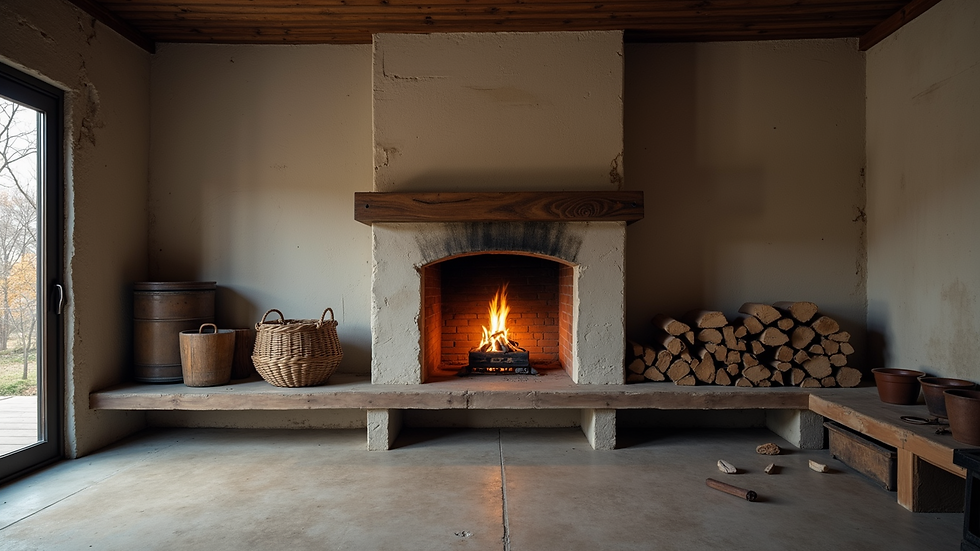Safety Tips for Using Modern Fireplaces
- tom98084
- Jul 7
- 4 min read
Modern fireplaces offer warmth and ambiance that can enhance any space. However, while they are a stylish addition to your home, safety should always be a top priority. Understanding how to safely use, maintain, and enjoy these fixtures is essential for all homeowners. This post provides practical safety tips to ensure you can enjoy your fireplace without unnecessary risks.
Fireplace Safety
Fireplaces come in various forms, including traditional wood-burning models, gas-powered, and bioethanol versions. Each type has unique characteristics and safety guidelines. For example, traditional wood-burning fireplaces require proper ventilation and regular chimney maintenance. On the other hand, gas and bioethanol fireplaces need specific safety measures due to their reliance on fuel.
Understanding your fireplace's specific needs is crucial. For instance, the National Fire Protection Association (NFPA) recommends that homeowners routinely inspect their fireplaces, flues, and chimneys to prevent fire hazards and ensure optimal performance. Homeowners should also consider installing smoke detectors and carbon monoxide detectors in proximity to their fireplaces for enhanced safety.

One effective way to maintain safety is to create a clear area around the fireplace. This includes removing flammable materials, such as furniture, pillows, or decorations, within at least three feet of the fireplace. Minimal clutter reduces the risk of accidental ignitions. Additionally, consider using heat-resistant mats or screens to prevent embers from escaping and igniting nearby materials.
Essential Safety Equipment
Equipping your fireplace area with the proper safety gear is crucial. Fire extinguishers should be kept within reach, especially if your home uses a wood-burning fireplace or any fuel source. The NFPA recommends having a multi-purpose fire extinguisher on hand, which can combat various types of fires.
Another essential safety measure is to have a sturdy screen or glass door for your fireplace. These barriers serve to contain sparks and embers, minimizing the chances of accidental fires outside the fireplace. If your fireplace is designed for logs, always utilize a fire grate to ensure proper air circulation and reduce the risk of overheating.

Always keep tools for managing your fire, such as a poker, tongs, and a broom, nearby. These items help you tend to your fire safely while maintaining a safe distance. Furthermore, educate family members on the proper ways to use these tools to encourage a culture of safety in your home.
Is a Bio Ethanol Burner Safe?
Ease of use is a significant reason many homeowners opt for bioethanol fireplaces. Unlike traditional wood-burning fireplaces, they require no chimney or flue and produce no smoke. However, safety concerns sometimes arise regarding these modern appliances.
Bioethanol is a clean-burning and renewable source of energy; however, it is still a fuel, and its use requires adherence to specific safety guidelines. Always ensure proper ventilation when using a bioethanol burner to prevent the accumulation of fumes. Additionally, never leave a lit bioethanol fireplace unattended, and keep it away from flammable materials.
If you're considering a bioethanol fireplace, you might wonder, are bio ethanol fires safe? It's vital to research reputable brands and models, ensuring they come with safety features such as automatic shut-off mechanisms.

Before fueling your bioethanol burner, allow it to cool completely to minimize flare-ups. Always use bioethanol fuel designed for fireplaces and specifically avoid other types of alcohol, as they are not safe for indoor use.
Regular Maintenance
Regular maintenance is crucial for ensuring the safe operation of your fireplace. For wood-burning models, get your chimney cleaned and inspected at least once a year. Creosote buildup can cause chimney fires, so regular cleaning is essential.
Gas fireplaces should also undergo annual inspections to ensure that gas lines are intact and functioning. Any signs of leaks, such as a rotten egg smell, require immediate attention. Bioethanol fireplaces, while simpler, should be regularly checked for damage, and the burner containers must be cleaned and maintained to promote safe use.

Additionally, change your smoke detector batteries at least twice a year to ensure they are operational. Carbon monoxide detectors are also vital if you use gas or bioethanol fireplaces. Keeping these devices functional can protect your household from unseen dangers.
Educate Your Family
Ensuring safety goes beyond equipment and maintenance; educating your family members is equally important. Teach them about fireplace safety from a young age. This includes the dangers associated with flames, how to operate tools safely, and the importance of maintaining a safe distance.
Establish rules for safe usage, such as no running or horseplaying around the fireplace. Children should be supervised when the fireplace is in use, and adults should model safe behavior. For instances where younger children are present, consider using a child-proof gate around the fireplace area.
Make it a family responsibility to keep the hearth area clean. Encourage older children to assist with tasks like cleaning ash or replenishing the fuel supply under adult supervision. This teamwork reinforces safety practices and helps instill a sense of ownership over the fireplace.
Final Thoughts on Modern Fireplace Safety
Keeping your modern fireplace safe requires diligence and education. By following practical tips and performing regular maintenance, you can enjoy the warmth and beauty of your fireplace without unnecessary risks. Take the initiative to educate your family about fireplace safety and equip your home with the necessary safety measures.
Creating a safe, enjoyable environment allows you to maximize the experience of having a fireplace in your home. Remember, safety always comes first—so well-maintained fireplaces can offer both comfort and peace of mind.




Comments